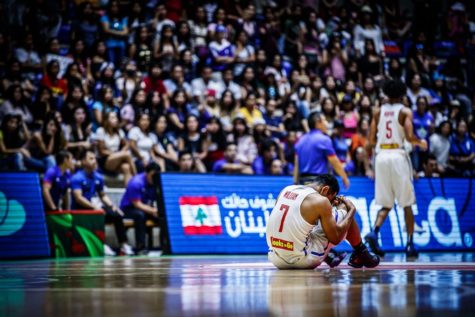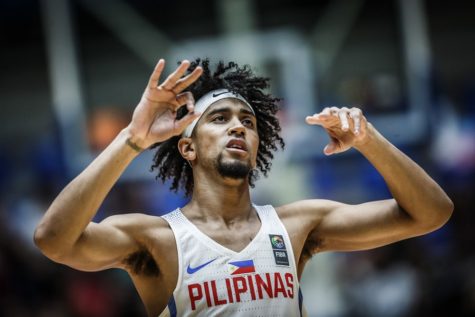Seven Takeaways from Gilas’s Seventh Place Finish in Lebanon
So, it is done. After a promising start to the FIBA Asia Cup highlighted by a three-game sweep of the eliminations, Gilas Pilipinas finished with a resounding thud, finishing a dismal seventh. Here are seven takeaways from the debacle in Lebanon.
1. Gilas is way behind.
That swashbuckling 3-0 start, capped by a dramatic, down-the-wire stunner over China (albeit the watered down version), was all smokescreen as it obscured the harsh reality that this iteration of the national team is, in fact, way behind its rivals both from Asia, and more so, from Oceania. That harsh reality was none more evident than in the least three games: a complete, utter annihilation at the hands of the South Koreans; a shellacking from old man Fadi El-Khatib and his Cedars; and a rather disappointing saved-from-the-jaws-of-defeat win over the Jordanians.
[adinserter name=”singlepost”]
Long story short, the national team—and really, it might be quite ironic to call the team “Gilas” given its disappointing fourth place showing in the 39th Jones Cup and its lowly seventh place finish in the recent FIBA Asia Cup—got exposed. It was woefully unprepared, flawed on both offense and defense, and at times surprisingly overwhelmed by the moment, save for unflappable veterans Jayson Castro and Gabe Norwood and the always unconscionable Terrence Romeo.
2. Romeo is not ready.
Speaking of Romeo, he was quite certainly one of the darlings of the tournament with his flowing hair, irrepressible flair, hypnotic handles, and streaky shooting. Unfortunately, he is not yet ready to take the reins from Jayson Castro, twice adjudged as Asia’s best point guard.
Yes, Romeo is a bonafide talent, gifted with the ability to put points on the board from a variety of angles and against the tightest of defenses. Yet this gift remains Romeo’s curse. The kid from Cavite is still, to the core, a gunslinger without a conscience, a feast-or-famine volume scorer who can shoot you back into a game in a hurry or shoot you out of it just as quickly. He is not a point guard, and he likely will never be.
There is no middle ground with Romeo just yet. Romeo is an all-world asset when his shot is on, but when on a cold spell, the man is a liability on both ends. He is less-than-stellar on defense, not quick, or most likely, not tenacious enough to cover cat-quick guards and not tall and strong enough to handle bigger guards. On offense, he has a tendency to dribble the ball for 15 to 20 seconds before either settling for a contested jumper or passing—usually out of necessity—to a teammate standing still on the perimeter, likely mesmerized watching Romeo’s dribbling display, disgusted by it, or drinking Gatorade on the sideline. (On another note, the Philippines would have surely gotten gold if fancy handles counted as points.)
Watch: Terrence Romeo Highlights vs China Video
3. Castro needs to take charge.
There is a reason why Jayson Castro was twice hailed as Asia’s finest point guard: he is a playmaker extraordinaire, adept at creating both for himself and for his teammates. More importantly, he knows when to look for his shot and when to share the wealth. But in the recent FIBA Asia Cup, Castro looked like a man ready to pass the torch, deferring time and again to the younger Romeo. Gone was the Castro of old—decisive and dynamic, cool and in control—who stared down opposing guards before pulling up for dagger threes or exploding to the basket. Instead, Castro often called for Romeo to get the ball and then stood still just like everyone else, watching Romeo do what Magoo Marjon affectionately describes as a “dance.”
That version of Jayson Castro is not what the national team needs. Team Pilipinas needs Jayson Castro in “The Blur” mode—aggressive and assertive, ready to lead, and willing to take on all comers. The torch will have to be passed soon enough, but now is not the time yet; there is still plenty of good basketball left in the tank of one of Asia’s finest guards, and his best will be needed come November.
4. Gilas needs Gabe.
Nothing about Gabe Norwood stands out to casual basketball fans, save for the occasional flashes of all-world athleticism (like when he put NBA vet Luis Scola on a poster in the 2014 World Cup or when he dropped a lefty hammer in that same game against Argentina). But Gabe is a high IQ, do-it-all glue guy whose contributions do not always show up in the box score but are nonetheless critical to winning basketball games. He plays terrific, fundamentally sound defense. He is a serviceable rebounder. He is an excellent secondary or tertiary ball handler who can set the offense. He also has this uncanny knack of just making the right play, whether giving the extra pass, setting a timely screen, retrieving a loose ball, shooting that one-driblle pull-up, closing out on a shooter, or getting back on defense.
Perhaps more importantly, Norwood is the play-the-right-way kind of player whose leadership is invaluable to a team full of young guns and combustible personalities. Mr. President’s international career is winding down, maybe on its last legs even, but he remains an effective player, a solid, if unspectacular, contributor in so many ways, a leader in words and deeds, and a great ambassador for Philippine basketball. In short, Gabe is a player every coach would want, and he is exactly the type of player Gilas needs.
[adinserter name=”InArticle”]
5. The dribble drive is outdated.
The dribble drive offense was effective in 2013 largely because that iteration of Gilas had adequate time to prepare; a trio of crafty and decisive playmakers in Castro, Jimmy Alapag, and LA Tenorio; and knockdown shooters in Jeff Chan, Larry Fonacier, and Gary David. That national team also had the element of surprise. Four years later, Gilas’s rivals are now well versed on that dribble-drive system, and they finally know how to defend it. They have seen it, they know what is coming, and for the most part, they can stop it.
6. Gilas has no changeup.
In baseball, the changeup is an offspeed pitch delivered by pitchers to give hitters something else to watch out for and keep them off-balanced. Gilas does not have a changeup, or at least one that works, whether on offense or on defense.
When the dribble drive doesn’t work, Gilas goes to either the high pick-and-roll or the Terrence Romeo Special (really, just an isolation with lots and lots of dribbling that end up in a contested shot); unfortunately, locked-in, quick-switching defenses pretty much swallow both plays with ruthless efficiency now. On defense, on the other hand, Gilas can’t give opposing offenses varied looks. It can’t zone effectively due to a confluence of factors, mainly, the unfamiliarity with the zone, the lack of time to work on it, the lack of fundamentals and discipline in playing defense, and the lack of all-out-effort, which ironically is supposed to be the hallmark of #puso. (Watch the game against South Korea again and the first and fourth quarters of the Lebanon game. See how many open looks Gilas gave up.) Gilas can neither press nor trap, too, as smart players from elite teams regularly carve up disjointed, half-hearted traps.
Watch: Gilas Pilipinas vs South Korea FIBA Asia Full Highlights
7. Gilas was outcoached.
To be fair, Gilas got very little time to prepare for the FIBA Asia Cup, but that is not an excuse to be outcoached so thoroughly by pretty much every elite team. The coaching was borderline mediocre, especially in those two embarrasing blowouts against South Korea and Lebanon. Adjustments seemingly came in trickles only, usually made three to four plays late and pretty much ineffective anyway. There were no new wrinkles, both on offense or on defense, no surprise plays and ploys, and no improvement from the first game to the last one.
Not to add salt to the wound, but watch that game against South Korea again. Watch how South Korea clamped down on Terrence Romeo in the second half after he single-handedly kept Gilas afloat with that scintillating second quarter salvo. Watch how the South Koreans methodically broke down Gilas’s defense to get open look after open look. Then go back to that Lebanon game. Watch how old man Fadi El-Khatib and Norvel Pelle, a 6-11 pogo stick, shredded the Gilas defense pretty much the entire game because, really, Gilas couldn’t figure out how to stop them. Watch how the Cedars brought out the press break in the second half to counter the soft press of Gilas.
If it is any consolation, PBA commissioner Chito Narvasa was right—what matters is not the FIBA Asia Cup but the World Cup qualifiers that begin in November. Unfortunately, much work needs to be done in three months’ time before Gilas can even be truly competitive against the region’s elite.
But remember, Gilas has beaten longer odds before. Maybe Team Pilipinas can do it again.
 Written by Martin Dale D. Bolima.
Written by Martin Dale D. Bolima.
Martin is a copy editor for the University Press of First Asia. He is an avid sports fan. He used to keep a sports blog at http://pinoysportsnet.blogspot.com/.
Photos from fiba.com








Great analysis. We dont need Romeo and Chot in the team; that is my personal assessment
I agree with this article, very well written.
I wish gilas pilipinas the best come November.
PUSO!
our Gilas coaching staff/players and specially the fans can learn a lot from this article.
This accurate assessment of GILAS’ failure would have been PERFECT, had the writer included GILAS’ — like other Phil teams’ — atrocious FOUL SHOOTING… especially Fil-German Standhardinger. AND THE WHOLE GILAS TROOP as well…. Please, do remedy that AILMENT before November. NOW. ASAP. ORAS MISMO. PRONTO!
The writer hits the nail right smack on the head when he deplored Gilas’ lack of coaching expertise. Chot’sstyle, esp that damn dribble-drive-deal thingie is already obsolete and over-scouted by their rivals. The sad thing is Coach Chot has NOTHNG MORE IN HIS COACHING MIND, esp in the area of DEFENSE. Solution here is so simple: DUMP CHOT. GET CONE. EVEN BLACK. Just, for Heaven’s sake… NO MORE CHOT FROM HEREON IN!
we need a coach like compton especially on the defensive ends.
Gilas needs Romeo as a long-range shooter and not a dribble-all-the-way point guard; Gilas also need more 3&D shooters like Maliksi and not undersized defender like Abueva who is also a liability with his antics; Gilas needs most of all a new mobile long-range shooter and who can defend the rim naturalized player like in the mold of Blatche (or more) which will give the surprise element; and of course Gilas needs more time together to blend them well
We should use the World Cup (if we could make it), as a perferct training program to hone our skills in preparation for a much coveted plum as King of Asian basketball in the 18th Asiad in Jakarta. It has been a 56 year title drought since we last claimed basketball supremacy in Asia.
First of all, if i were coach chot the first thing i would do is to apologize to gabe norwood on air or in public. He was not even on the original roster of this version of gilas and was only named as an replacement. He is the only bright and consistent spot and thinks team before self mentality…but im not coach chot…bring baldwin and blatche back then we can hope again
A very well written article. Just unbiased, well-thought-out and brutally honest. I have never been a fan of Coach Chot’s sytem and how he runs the team. I really thought Coach Tab was a great tactician and a no frills kind of coach. He brings the best out of everybody and holds them accountable. Remember, he brought Gilas 5.0 to the FIBA Asia Finals. That iteration of Gilas is definitely not on the level of this latest version of Gilas, to be honest. Gilas needs Coach Tab back and needs to implement a new system.